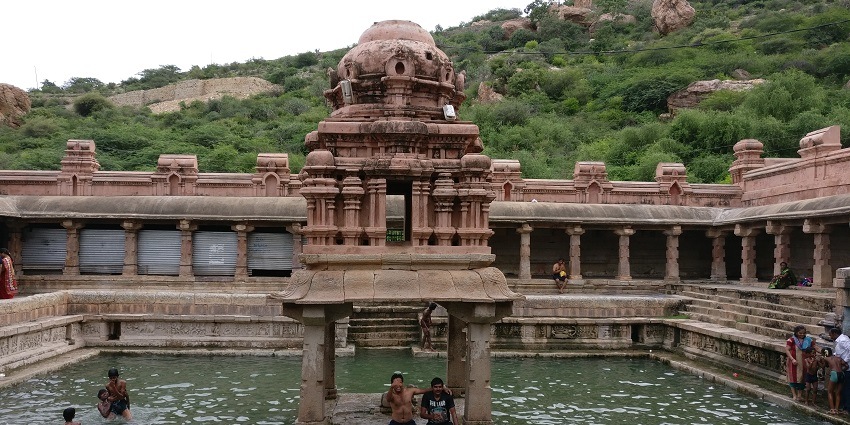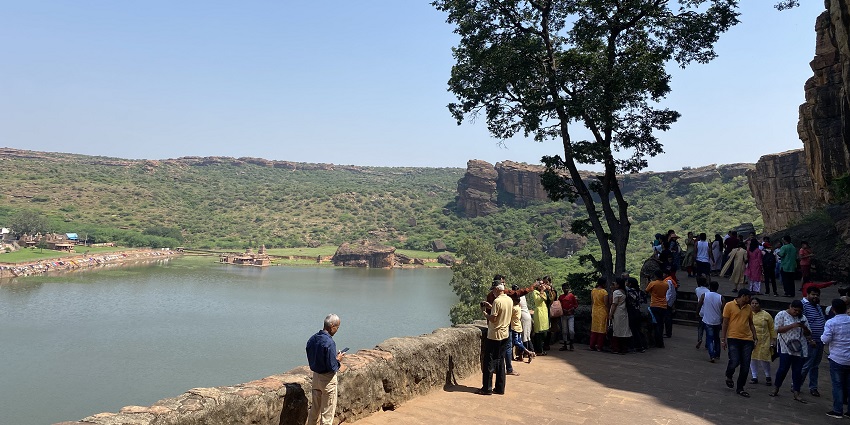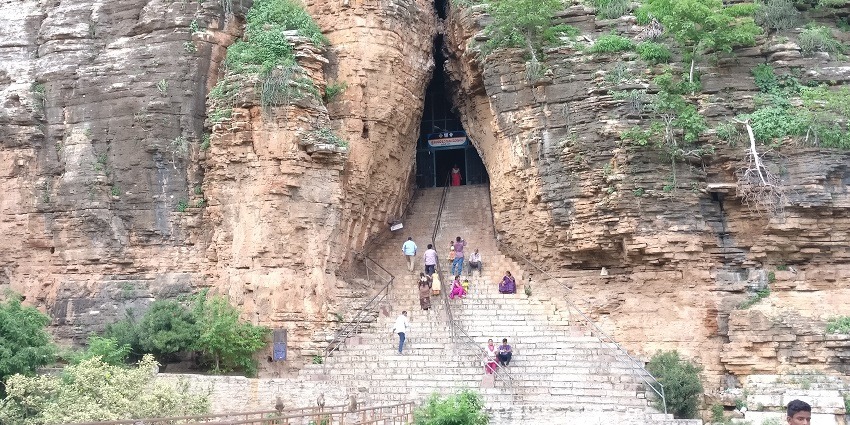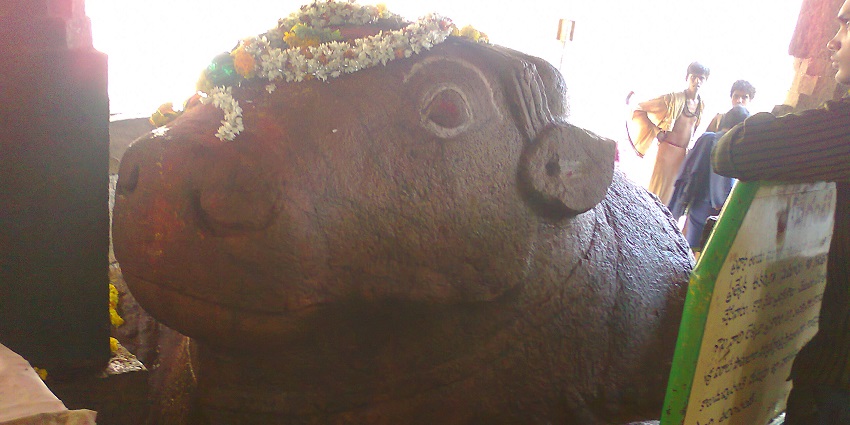In Andhra Pradesh’s Kurnool district, Yaganti Temple is a historical and spiritual treasure. Built in the fifteenth century by Sangama Dynasty ruler King Harihara Bukka Raya, this temple is well-known for its magnificent Dravidian design and mysterious Nandi deity that seems to be growing. In addition to devotees, who swarm here to seek blessings from Lord Shiva, history buffs are drawn in by the temple’s artistic magnificence and tales. Yaganti Temple is a perfect combination of history and spirituality.
Location

Photo: Andrea Piacquadio / Pexels / Image For Representation Only
Yaganti Temple is in Yaganti village, about 70 kilometres from Kurnool, 55 kilometres from Nandyal city, and 14 kilometres west of Banaganapalle (Mandal headquarters) on the Banaganapalle-Peapully road. The temple is deep within the Nallamala Hills, a part of the Eastern Ghats that separates northern India from southern India. The temple is easily accessible from most major cities in India.
Suggested Read: Sri Lankamalleswara Wildlife Sanctuary
How To Reach Yaganti Temple

Photo: Harrison Faux / Pexels / Image For Representation Only
The temple is well connected to the major cities in Andhra Pradesh, by road and railway.
By Road: Yaganti is well connected by road. From Kurnool, you can take a bus or a taxi to the temple. There is a bus stop at Yaganti Temple, and buses from Kurnool drop off numerous devotees at the gates of the temple. Buses are cheaper than taxis, but both of them will drop you directly at the temple.
By Railway: The closest train station to the temple is in Nandyal, roughly 55 kilometres away. From Nandyal, you can take a taxi or a bus to Yaganti.
Things To Do
1. Witness Pushkarini

Photo: Saisumanth532 / Wikimedia Commons
This temple is popular for its Pushkarini, a small pond of water on the temple grounds. Water falls into this Pushkarini from the bottom of the hill through the mouth of a Nandi statue. The water is fresh and pleasant because it comes from the hills. No one knows how the water gets to the pond all year, and the temple architecture and art show the talents of ancient Viswakarma Sthapathis. Devotees believe that taking a holy bath in Pushkarini is extremely beneficial for their body and soul.
Timings: 6 AM – 6 PM
Suggested Read: Rollapadu Wildlife Sanctuary
2. Explore Agastya Cave

Photo: Vinayaraj / Wikimedia Commons
The Agastya Cave, near the temple, is named after the respected sage Agastya, who is said to have performed his penance to Lord Shiva in this place. The cave is on the bank of Agastya Lake, named after the great sage who lived here. The cave houses a tiny shrine dedicated to Lord Venkateswara, and devotees travel through the challenging cave to visit this small idol inside the temple. The walk through the cave is one of the most exciting experiences one can have.
Timings: 6 AM – 8 PM
3. Stroll Through Venkateshwara Caves

Photo: Saisumanth532 / Wikimedia Commons
The cave houses Lord Venkateswara’s damaged murti that was supposedly built by Sage Agastya. Compared to the Agastya cave, it is easier to climb, but the steps are rough. According to folklore, this murti existed in the cave before the Tirumala Venkateswara Temple was built. However, because of the damage to the toes of the idol, the murti could not be worshipped. This small cave is seen as an alternative to Tirupati Temple. It is an easy trek surrounded by beautiful landscapes.
Timings: 7 AM – 8 PM
Suggested Read: Hill Stations In Andhra Pradesh
4. Witness Growing Nandi Idol

Photo: Just4santosh / Wikimedia Commons
One of the temple’s unique features of Yaganti Temple is the statue of Nandi, the sacred bull and vehicle of Lord Shiva, which is believed to be expanding in size. According to local legend, this Nandi deity, unlike others, has slowly expanded in size over the years. Geologists suggest that this is due to the specific rock type that was used to carve the bull’s idol, but the phenomenon remains an intriguing mystery that draws many people from all over the world.
Timings: 24*7
Where To Stay

Photo: Pixabay / Pexels / Image For Representation Only
You can stay at the Haritha Hotel, managed by the Andhra Pradesh Tourism Development Corporation, which offers comfortable accommodation near the temple. It offers limited amenities, but it is an excellent choice for pilgrims looking for a comfortable stay. Nandyal, around 55 kilometres from Yaganti, also has plenty of hotel options. The most common options among visitors are Hotel Suraj Grand, Sri Brindavan Residency, and Nandyala Residency.
Suggested Read: Things To Do In Araku Valley
Where To Eat

Photo: Marvin Ozz / Pexels / Image For Representation Only
Around Yaganti Temple, there are small eateries and food vendors that serve simple vegetarian meals, snacks, and beverages. These are perfect for a fast snack or a refreshing break. If you are staying in Kurnool, you’ll be able to have a greater range of food options. Nandini Family Restaurant, Hotel Sree Kanakadurga, and Uma’s Kitchen are some of the restaurants in Nandyal that serve wonderful South Indian and other Indian cuisine.
Best Time To Visit Yaganti Temple

Photo: Usha Kiran / Pexels / Image For Representation Only
The best time to visit is around the Maha Shivaratri festival, usually held in February or March. During this occasion, the temple is fully decorated, and special rituals and celebrations are performed to attract a large crowd of believers. The ceremony takes place with several rituals and ceremonies, including the Shiva Linga’s Abhishekam in milk, honey, and other precious materials. Devotees sing mantras and pray throughout the night.
Suggested Read: Bavikonda Ancient Buddhist Monastery
Other Factors To Consider

Photo: picjumbo.com / Pexels / Image For Representation Only
Here are a few things you must consider when visiting Yaganti Temple:
- Yaganti Temple is a religious site, therefore visitors are expected to dress modestly. Traditional clothing is recommended, especially when entering the temple premises.
- Footwear cannot be worn within the temple, so wear comfortable, easily removable shoes. Also, keep your shoes in their proper spot so they don’t get mixed up with other shoes.
- Maintain cleanliness in the temple and its surrounding areas. Avoid littering and respect the natural beauty of the region.
- Hiring a local guide can improve your visit by providing unique details about the history, architecture, and mythology around the Yaganti Temple.
Yaganti Temple offers visitors a powerful and unforgettable experience, blending spiritual significance, historical beauty, and breathtaking scenery. From the mysteriously growing Nandi and peaceful Agastya Cave to the sacred Pushkarini and colourful festivals, every part of this temple shows a story of devotion and astonishment Yaganti Temple is a lot more than a holy place. To explore the holy Yaganti Temple, book your trip with TripXL!
Cover Photo: P. Madhusudan / Wikimedia Commons


 WhatsApp
WhatsApp
 Twitter
Twitter









